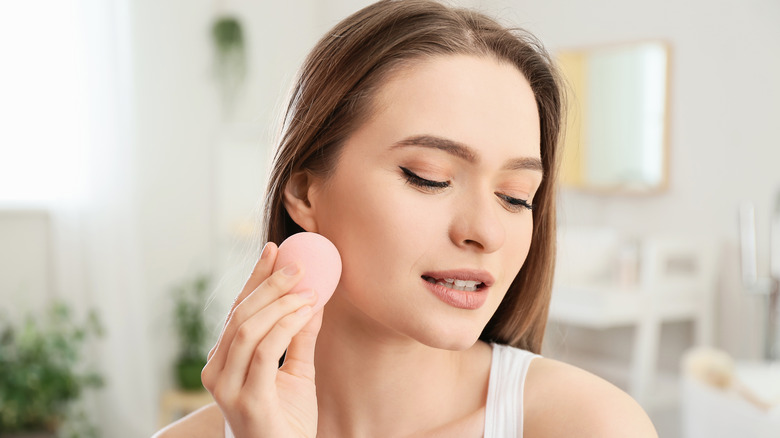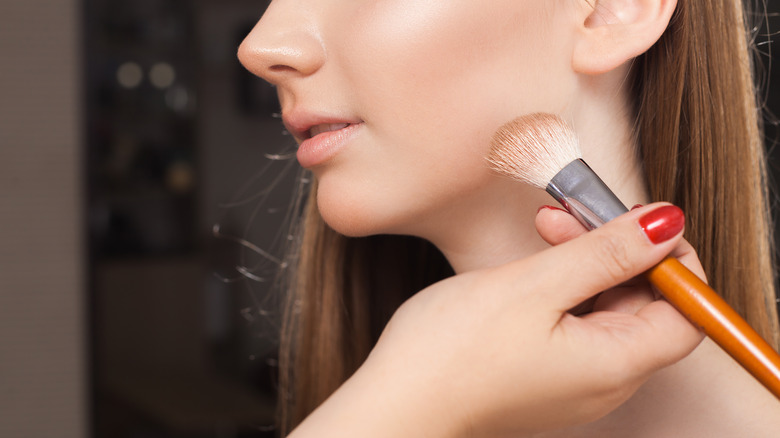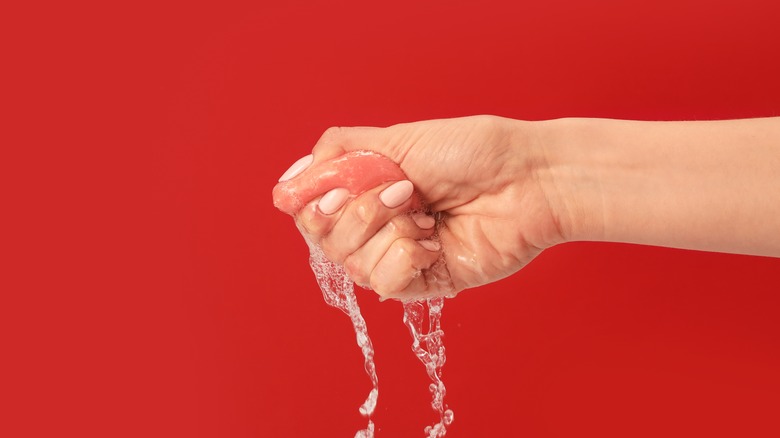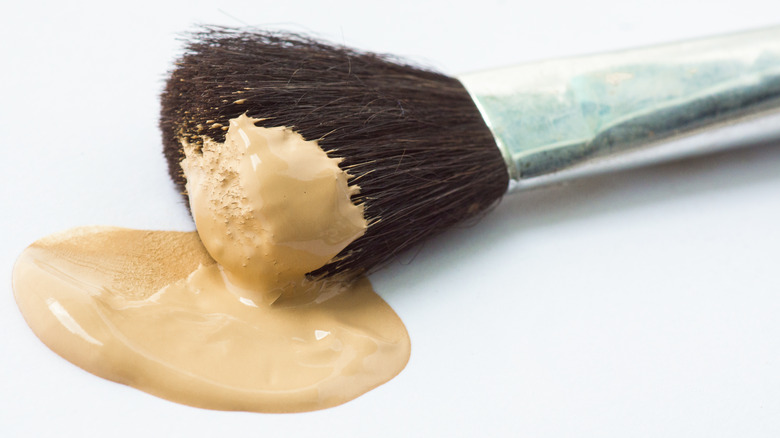Mistakes To Avoid When Blending Your Makeup
Blending your makeup is just as much of an art form as applying it; and, if you aren't careful, your expertly applied products can look anything but when blended. When it comes to base products — like foundation, concealer, bronzer, and blush — that are meant to enhance your complexion, the goal is to make it look like you aren't wearing any at all. Blending your complexion makeup properly can make all the difference in whether you look flawlessly airbrushed or like you simply have a lot of products sitting on top of your skin. Unlike eye makeup, which often intentionally utilizes defined lines to amplify a bold eyeshadow look or to create a sleek cat eye, your base makeup should not have any lines of demarcation that immediately call attention to the fact that you are wearing it.
Avoiding the most common blending mistakes can help ensure your makeup blends seamlessly into your skin.
Not prepping your skin beforehand
Prior to applying any makeup, your skin should be properly prepped to provide the best possible base for all of your makeup products.
One of the most important steps in creating a smooth, flawless base layer for your makeup is moisturizing. Moisturizing prior to applying any makeup gives your products something to adhere to and helps your makeup blend effortlessly into your skin. It also helps nourish and hydrate any dryness that makeup tends to accentuate.
If you are particularly prone to visibly dry, flaky skin that becomes more pronounced the moment you start blending your makeup, incorporating a chemical exfoliator into your regular skincare routine can help. When you have flakes or dry patches, celebrity makeup artist Bhavya Arora says that attempting to blend in your makeup over the top will cause it to adhere to the dry patches rather than absorb into your skin itself (via Vogue). Regularly exfoliating and working a moisturizer into your daily routine will help keep your skin looking and feeling its best while giving you the best chance at slaying your makeup game.
Blending your makeup into oily skin can also cause a makeup meltdown the moment you try to blend. If you are prone to oily skin, using a matte primer can help prevent your makeup from slipping and sliding and will help it adhere where it's supposed to. "If there's too much oil on the skin, creams will get blotchy and powders will grab," says celebrity makeup artist Quinn Murphy, who recommends always using a primer before foundation for the smoothest possible finish (via Allure).
Not blending down your neck
The key to making it look like you aren't wearing any makeup is by wearing it in a way that makes it look like an enhanced, flawless version of your own skin. And, while the goal is always to use a shade that matches your natural complexion as closely as possible, the reality is that no store-bought pigment will ever perfectly match yours perfectly. Improperly blended makeup can leave you looking two-toned, and not blending your makeup over the entirety of your face can leave your complexion looking uneven. "The biggest mistake people make when blending foundation is that they don't cover all the areas of their face, including their eyelids, their jawline, and their hairline," says celebrity makeup artist Riku Campo (per Allure).
Additionally, concentrating your makeup onto just your face and neglecting to drag the product down your neck, onto your chest, and even onto your ears can create harsh lines of demarcation where the product stops that are anything but subtle and natural. "Your skin doesn't stop at your jaw — blend your complexion down your neck so your foundation looks seamless and more natural," adds makeup artist Ciara Gilonna (via In Style). When blending your makeup onto your jawline and down your neck, give each side profile a final glance in the mirror before heading out to ensure you look seamless from all angles and not just from straight on. Lines of demarcation can be hard to spot without turning your head.
Not wetting your makeup sponge
If you are using a makeup sponge to blend your makeup, one of the biggest mistakes to avoid is not wetting it beforehand. "Makeup sponges are meant to be used damp, so remember to run it under your faucet and squeeze all the excess water out," says Ciara Gilonna (via In Style). "A damp sponge softens the application process when the product goes onto the skin, allowing it to blend easily."
Not only that but applying your makeup with a damp sponge will help you use (and waste) less of your expensive product. Because makeup sponges are designed to absorb water, they can also inherently absorb a lot of product if you aren't careful. By wetting your sponge, you are saturating it with water, making it too saturated to absorb as much makeup as a dry sponge would. Blending your makeup with a wet sponge allows you to not use any more product than the amount needed for your face.
Sweeping instead of stippling
In addition to making the mistake of blending with a dry makeup sponge, many people often treat their sponge as more of a paintbrush than a stippling tool, which can leave you looking more streaky than seamless. Instead of dragging the sponge across your face using a sweeping motion when blending, try using it to tap the makeup into your skin using a bouncing motion. "Otherwise, you're literally wiping it off while applying," says celebrity makeup artist Lottie (per The Zoe Report). In addition to creating a streak-free finish, stippling your makeup into your face using a damp blender can help it more easily melt and blend into your skin as opposed to settling on top of it.
Much like with sponges, when using a makeup brush, you should avoid swiping the product onto your skin, as this motion can unintentionally move makeup around and wipe it off in areas where you want coverage. "Brushes function like little brooms and sweep product on or off of the skin, so you want to be applying deliberately where you want the product to be detected and then blend until you have the desired look," says Rea Ann Silva (via In Style). To achieve this, Ciara Gilonna recommends blending with your brush using "small, circular motions" as opposed to using it to drag and pull the product. This will help it blend seamlessly into your complexion.
Using too much product
If you have applied too much makeup, you will know the moment you try to blend it out. While using too much product is a common mistake, it's also one of the easiest to avoid. Whether you are blending your makeup with a sponge or a brush, it's best to start with minimal product and build coverage if you need to, since it's easier to add more than to have to take it off after realizing you've added too much.
Applying your makeup directly onto your face or onto your brush or sponge can cause you to mistakenly use too much product, which is why it's best to apply the makeup to the back of your hand so you can more easily control the amount going onto your brush and coming into contact with your face. Not only does this method help you better control the amount of product you're using, but Gilonna adds that it also helps warm the product before it touches your face, which helps it melt more easily into your skin (per In Style).





